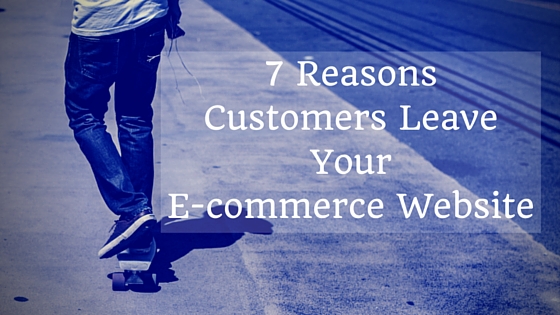7 Reasons Why Visitors Leave Your e-Commerce Website

Getting people to your eCommerce website is the first step. Having them stay and make a purchase is the most important. Much of the online shopping world is based on ease of use so when your website contains roadblocks in the buying process, it’s usually because something isn’t easy or readily available.
Here are 7 reasons why your online shoppers are abandoning their shopping carts or leaving your website for another:
Slow loading times
Think about why people shop online - it’s generally motivated by convenience. It’s supposed to be the quick and easy alternative to going to a mall, fighting for a parking spot, waiting in lines, etc. So when someone comes to your eCommerce site in the hopes of quickly purchasing your wares, making them wait is like begging them to NOT shop at your store.
In a study conducted by Akamai and Gomez, they found that page loading times directly relate to whether or not a visitor will stay through to checkout or abandon their shopping journey. After interviewing 1,048 online shoppers they found that:
- 40% of people will abandon a webpage if it takes more than three seconds to load
- 14% of people will start shopping at a different site due to long page loading times
- 23% of people will stop shopping altogether and walk away from their computer if the page loading speeds are lengthy
- 64% of online shoppers who’ve had a bad experience at a site will likely never return to the site and shop elsewhere
For the sake of your own bottom line, ensure that your web pages load quickly. Not only does this make your customers happy, Google smiles upon this too because it uses site speeds as an indicator in their search algorithm. If you want to show up in Google search results and want your customers to buy from you, make your page loading speeds quicker.
Poorly Presented Products
Poorly presented products present poorly. When making a purchase online, potential buyers want to be able to get the product information they seek quickly. Confusing product information makes for confused customers who will turn to another site to find the details that they want. By including visualization tools you help to reveal the smallest details of the product you’re selling which in turn aids your consumer, revealing to them the finer accents of their potential purchase. With this ability to see the product in greater depth, trust is gained in the product and that trust carries over to your buyer and to you as a seller.
Complicated Customer Service
Enough with the automated responses, people like people. Sure they want to shop online but when they have a question, they want to speak to a real person who can address their concerns rather than have an auto email sent back to them. Also, to make it easier for your customer, be sure that your website includes:
- An FAQ section containing answers to questions visitors may potentially have
- An easily available support method
- Video tutorials if possible that guide them through the process
- A structured and clear platform
Ineffective Search Features
The point is you’re trying to provide an effortless shopping experience for your customers and the search feature on your website is meant to act as a handy tool to help your customer find what they need. When your search feature doesn’t work, well, it’s equivalent to shopping in store and having a sales rep who knows nothing about anything in the store. Make sure the search feature on your website works. Another thing to consider is giving your online customers the ability to refine their search and set parameters for what they’re looking for whether it’s based on price, category or popularity. Remember, make the process of shopping as easy as possible for your visitors and they’ll stick around and buy.
Lack of Trust
Security is a huge issue for people online. They want to know that when they are wiring their money that it is going to a legit business, not some offshore company with zero guarantees. Show off your brand certifications if you have them.
Another good trust indicator comes through social proof, i.e. highlighting other customer testimonials, star ratings, comments and product reviews. When researching items, consumers will often look to other peoples’ opinions of the product to gage whether or not it’s a good fit for them. By having this information on YOUR website, they’ll have no reason to leave the page.
Unavailable Shipping, Delivery and Returns Policy
Shopping carts are abandoned when shipping information cannot be easily found or when the terms of delivery are not stated on a website. Why? Because how is someone supposed to know when to expect an item and how much it will cost them to have it sent. Nothing is worse than discovering just until you’re about to check out that that steal of a deal of a product is now the same as buying it full price because of shipping costs.
Be transparent about shipping costs and delivery dates from the get go. Shoppers DO abandon carts when the cost of shipping is too high. Free shipping is always preferred.
Blatantly state your returns policy including how a return can be made if there is something wrong with the product once it is received.
Out of Stock Products
Provide stock information. Nothing is more frustrating than finally settling on an item you are going to purchase, going through the shopping cart steps and then receiving a note back that says the item is not available. I wasted all that time! Be kind to your customers and let them know what you do have and what you don’t. If they have a great experience on your site, they’ll come back and tell their friends about it. If they don’t have a great experience, well, there goes that sale and all the other potential sales that could have been had from their network. Be smart about your eCommerce site.

